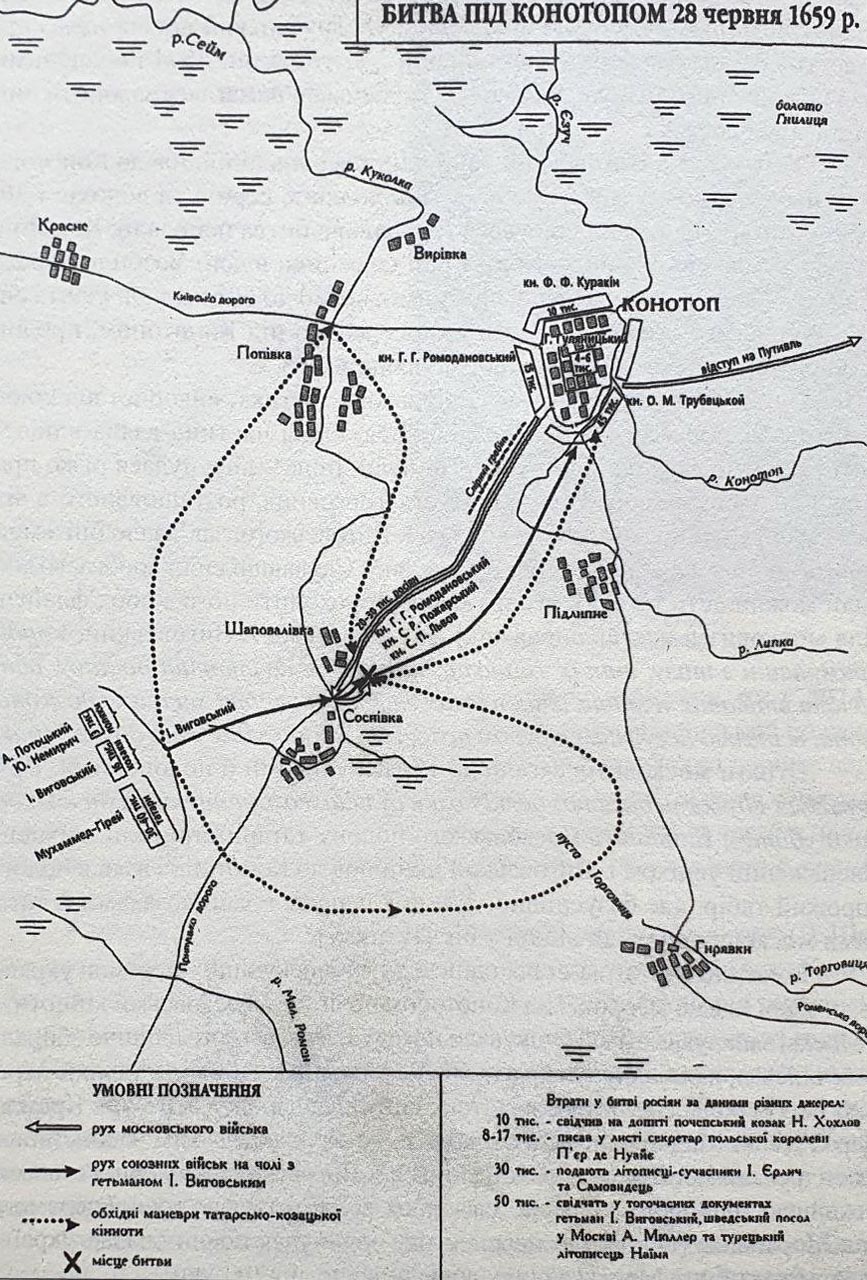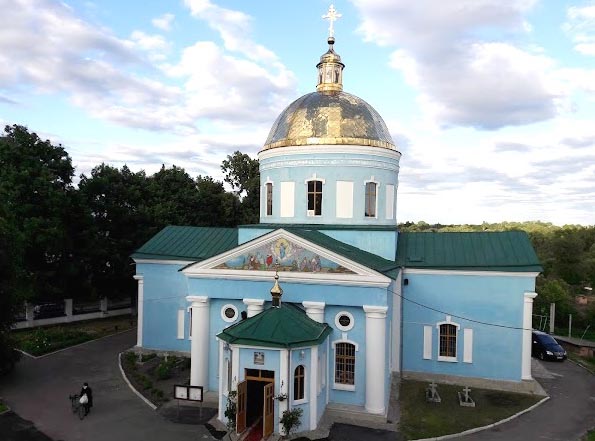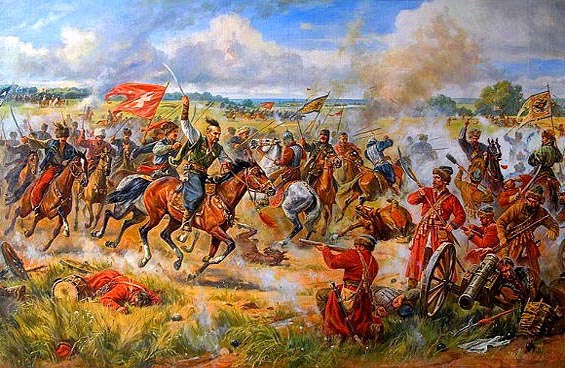Battle of Konotop. Artist A. Orlonov, 2010.
https://upload.wikimedia.org/wikipedia/commons.jpg
For many centuries, the Russians have been proud of their victorious and undefeated army, “glory of the Russian arms” and many battles and wars won. Nowadays, the Russian propaganda continues claiming military prowess and invincibility of the own army. Nobody in the whole world could allegedly ever overcome it. As for the war campaigns, the Russia wages only the liberation wars and those for protection of the own territory and the territories of the friendly nations. Actually, it is far from the truth. One of the examples of such liberation wars and the invincibility of Russian weapons is described in the article devoted to the Battle of Konotop by Ihor Kocherhin, the doctor of historical sciences. The Battle of Konotop was fought 363 years ago. The defeat of the Russians army on 28 June in 1659
After Bohdan Khmelnytskyi died in 1657, Ivan Vyhovskyi, the general chancellor, was elected to be the new Hetman. Ivan Vyhovskyi initially had pro-Muscovite orientation in the external policy. However, Moscow was not inclined to respect the sovereignty and territorial integrity of Ukrainian Cossack State, though such an attitude contradicted the earlier agreements. Firstly, the Muscovites tried to incite a civil conflict and supported the revolt within the Zaporozhian Host, to which Martyn Pushkar, the colonel of Poltava regiment, joined later. Ivan Vyhovskyi suppressed the revolt. After that, the Muscovite tsar ordered to deploy the zalohy (military units) in Chernihiv, Nizhyn, Murhorod, Poltava, Bila Tserkva and Korsun. Ivan Vyhovskyi and the part of the Cossack officers reacted to this with the decision to have peace treaty with the Polish.
On 8 September 1658, the Unia (Union) was concluded between the Zaporozhian Host (Hetmanate) and Rzeczpospolita in Hadiach (Hadziacz), according to which the Great Principality of Rus was to be formed within Rzeczpospolita and to symbolise the inheritance of the Cossack State from the Rus or Kievan Rus.
The reaction of the Tsardom of Muscovy to the Unia of Hadiach, was bursting the war against Ukraine.
On 20 October 1658, 20-thousand Moscow army headed by G. Romodanovsky entered into the territory of Ukraine. Before March 1659, the Cossack Host had almost expelled the invaders from the soil of Livoberezhzhia (Left-Bank Ukraine). However, another Moscow army headed by A. Trubetskoi and F. Kurakin entered into Ukraine. They laid siege to the town of Konotop, it was the town of sotnуk (military officer). Moscow forces numbered 70 000, while the defenders of Konotop were 4 000 Cossacks with Hryhoriy Hulianytsyi in charge.
On 28 June, the decisive battle was fought. The tactics was crucial in it. The Tatar army was divided: one part of it was relocated to the left, then they went North to the village of Popivka; the other part sharply turned right to the wetland of Pusta Torhovytsia. The main forces headed by I. Vyhovskyi started a battle with the Muscovite army near the crossing through the Sosnivka river. The next day, I. Vyhovskyi imitated the retreat. The part of the Muscovite army with S. Pozharsky in charge started chasing it but was ambushed in the village of Sosnivka and defeated completely. S. Pozharsky and other Russian nobles were captured.
The losses of the Muscovite army were 15 000 people, both killed and captured. On defeating the army of S. Pozharsky, the Cossacks and the Tatars continued harassing the retreating enemy during the 3 days until they reached the border.
The Cossacks killed in the battle were buried in one mass grave, called the brotherhood grave. This place was marked with the church established to honour the Forty Martyrs of Sebaste. The church grew into the Ascension Cathedral in Konotop, but people still call it the Church of the Forty.
The battle of Konotop became one of the brightest victories of the Ukrainian army. Near Konotop, the best Muscovite cavalry was defeated and the fear came into Moscow. However, the Ukrainians could not enjoy the victory. Ivan Sirko attacked Nogay Ulus and this made the Tatars go home. Jan II Kazimierz, the King of Poland, also refused to send the arms. Without the military support of the Tatars and the Polish, the Cossack Host appeared in a difficult situation and it led to I. Vyhovskyi lost his power, followed by the Ruin in Ukraine.

The current publication is based on open sources and quotes from the book by V. Brekhunenko (Брехуненко В. Війна за свідомість. Російські міфи про Україну та її минуле.‒ Київ, 2017.‒ 280 с.)
Ihor Kocherhin, the doctor of historical sciences, the head of the South-East Interregional Department of Providing Implementation of the National Remembrance Policy in the Regional Ukrainian Institute of National Remembrance, professor of Dnipro University of Technology, captain of the Ukrainian armed forces
translated by Oleksandra Myrhorodska
Див. статтю "Яка ж вона насправді «слава русскаво оружія»?"
Our Advice to Read:
Бульвінський А. Конотопська битва 1659 року.– Київ, 2008.– 64 с.
Бульвінський А. Українсько-російська війна 1658–1659 років: основні битви, стратегія, чисельність та склад військ // Україна та Росія: проблеми політичних і соціокультурних відносин.– Київ, 2003.– С. 174–218.
Горобець М.В. Еліта козацької України в пошуках політичної легітимації: сосунки з Москвою та Варшавою, 1654–1665.– Київ, 2001.– 533 с.
Мицик Ю. Гетьман Іван Виговський.– Київ, 2004.– 84 с.
Яковлева Т. Гетьманщина у другій половині 50-х років XVII століття. Причини і початок Руїни.– Київ, 1998.– 447 с.











